Pass Go and Collect on
Early Monopoly Games
by Bob Brooke
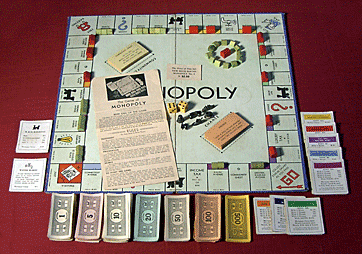 The
story of the game of Monopoly is the stuff legends are made of, full of
intrigue and a myriad of coincidences. Like the game, itself, the
almighty dollar drove its production and distribution, causing Parker
Brothers, the company who manufactured it, to fabricate an all-American
history to go with it–that Charles B. Darrow was its inventor. The
story of the game of Monopoly is the stuff legends are made of, full of
intrigue and a myriad of coincidences. Like the game, itself, the
almighty dollar drove its production and distribution, causing Parker
Brothers, the company who manufactured it, to fabricate an all-American
history to go with it–that Charles B. Darrow was its inventor.
The real story begins with Elizabeth Magie
Phillips, who created "The Landlord’s Game"in 1904. Played
on college campuses coast to coast and in Europe under different names,
the Game came in two parts. The first was like Monopoly, a game in which
there’s only one winner. Part two employs the same capitalistic
principles
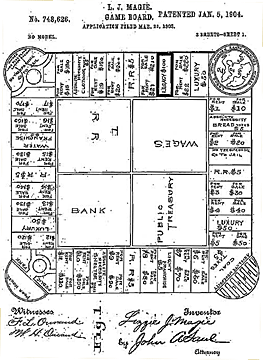 but mixes them with a healthy dose of tax reform, to prevent
the evils of monopolistic ownership, and then transforms all the players
into enlightened winners. Phillips wanted to change the world. As a
proponent of the economic ideas of Henry George, she designed her game
to teach the single-tax theory as an antidote to the evils inherent in
monopolistic land ownership. but mixes them with a healthy dose of tax reform, to prevent
the evils of monopolistic ownership, and then transforms all the players
into enlightened winners. Phillips wanted to change the world. As a
proponent of the economic ideas of Henry George, she designed her game
to teach the single-tax theory as an antidote to the evils inherent in
monopolistic land ownership.
The board for Phillips' game bears a striking
resemblance to the one for Monopoly, except that names, drawings, colors
and the like are different. It’s painted with blocks for rental
properties such as "Poverty Place" (rent $50), "Easy
Street" (rent $100) and "Lord Blueblood's Estate " (no
trespassing - go to jail). There are banks, a poorhouse, and railroads
and utilities such as the "Soakum Lighting System" ($50 for
landing it) and the "PDQ Railroad" (fare $100). And, of
course, there’s the famous "Jail" block. Players could only
rent properties on Phillips's board, not acquire them. Otherwise, there’s
little difference between The Landlord’s Game and the Monopoly of
today.
The Mystery Unfolds
Charles Darrow actually knocked off his
Monopoly from a game played by a group of Atlantic City Quaker teachers.
Like previous monopoly players, they had personalized their game after
being introduced to it by players from Indianapolis. They used their own
personal objects as playing pieces and played their game on homemade oil
cloth game boards.
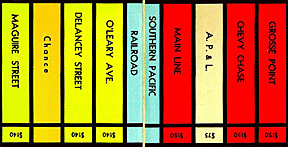 Ruth Hoskins, a young Indiana Quaker woman,
came to teach at the Atlantic City Friends School in the Fall of 1929.
Earlier that year, she learned to play a version of the Landlord's Game,
called Auction Monopoly, from her brother, who learned it at college.
Early in 1930, Hoskins taught it to her fellow teacher Cyril Harvey and
his wife, Ruth, and the Harveys played it with their friends Jesse and
Dorothea Raiford. It was Ruth Harvey who drew the first Atlantic City
Monopoly board with Atlantic City street names. Ruth Hoskins, a young Indiana Quaker woman,
came to teach at the Atlantic City Friends School in the Fall of 1929.
Earlier that year, she learned to play a version of the Landlord's Game,
called Auction Monopoly, from her brother, who learned it at college.
Early in 1930, Hoskins taught it to her fellow teacher Cyril Harvey and
his wife, Ruth, and the Harveys played it with their friends Jesse and
Dorothea Raiford. It was Ruth Harvey who drew the first Atlantic City
Monopoly board with Atlantic City street names.
The Harveys lent their games to Quakers staying
at Atlantic City hotels and also taught their relatives, Ruth and Eugene
Raiford, who, in turn taught their friend, Charles Todd, a manager of
one of the hotels. Todd then taught the game to his hotel guests Esther
and Charles Darrow. In fact, Darrow asked Todd for a dozen copies of the
rules.
But there’s one flaw in Darrow’s version of
Monopoly. Most players are unaware that the property known as Marvin
Gardens should actually be spelled Marven Gardens. It's a well-kept
residential section of $50,000 homes, built in the mid-20s by Frank J.
Pedrick & Sons. Since it’s located at the edge of Margate City
just across Fredericksburg Avenue from Ventnor City, two suburbs of
Atlantic City, Pedrick took the first three letters of each name, Mar
and Ven, and put them together to make it Marven Gardens. And that's the
way Ruth Hoskins and her friends put it on the original Atlantic City
Monopoly board, which was completed late in 1930.
There’s no question Darrow commercialized the
game, and his version with the locomotive trademark is the one most
widely known, but he was not the inventor.
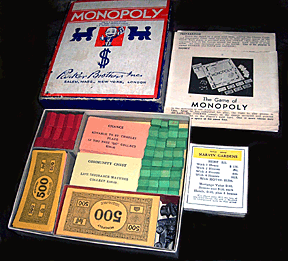 Unfortunately, Parker Brothers still sticks to
the story that one evening in 1930, Darrow sat down at his kitchen table
in Germantown, Pennsylvania, and sketched out some of the street names
of Atlantic City on the round piece of oilcloth that covered the table.
He included the three railroads that carried the wealthy vacationers to
the resort, and the utility companies that serviced them, as well as the
parcels of real estate of varying prices. He wanted a fourth railroad to
make his board symmetrical, so he added the Short Line: actually it was
a freight-carrying bus company that had a depot in Atlantic City. A
local paint store gave him free samples of several colors, and he used
them to color his game board. A new game began to take form in his mind. Unfortunately, Parker Brothers still sticks to
the story that one evening in 1930, Darrow sat down at his kitchen table
in Germantown, Pennsylvania, and sketched out some of the street names
of Atlantic City on the round piece of oilcloth that covered the table.
He included the three railroads that carried the wealthy vacationers to
the resort, and the utility companies that serviced them, as well as the
parcels of real estate of varying prices. He wanted a fourth railroad to
make his board symmetrical, so he added the Short Line: actually it was
a freight-carrying bus company that had a depot in Atlantic City. A
local paint store gave him free samples of several colors, and he used
them to color his game board. A new game began to take form in his mind.
He showed his game, which he called Monopoly,
to the executives at Parker Brothers in 1934. They rejected the game
because of numerous design flaws. But this didn’t daunt Darrow. The
game's exciting promise of fame and fortune inspired him to produce it
on his own.
The Commercialization of Monopoly
With help from a printer friend, Darrow
produced 5,000 handmade sets and sold them to Wanamaker’s, a
Philadelphia department store, and F.A.O. Schwartz, the famous New York
toy store. Demand grew until he couldn't keep up with the orders.
In the meantime, a friend telephoned Sally
Barton, daughter of Parker Brothers' founder George Parker, to rave
about a new game called Monopoly which she had purchased at F. A. O.
Schwarz. Barton told her husband, Robert B. M. Barton, the company
president, about the game. He purchased a copy from F. A. O. Schwarz,
took it home and wound up playing it until 1 A.M. The next day, Barton
wrote to Darrow, and three days later they met at Parker Brothers' New
York sales office. Parker Brothers offered to buy the game outright,
giving Darrow royalties on all sets sold.
The royalties from sales of Monopoly soon made
Darrow a millionaire. Newspapers and magazines wrote up Darrow as the
poverty-stricken genius who invented it. "Another Germantown First;
Monopoly Invented Here," read the front-page headline of the Germantown
Bulletin of Feb. 13, 1936. The story beneath it explained how Darrow
got the idea for Monopoly by reading a book about a boy in a commercial
school where students "were given scrip and allowed to purchase
stock with this make-believe money. A little bit of that book stuck in
his mind. The more he thought about it, the more ideas he got, until
finally, he went to work in his cellar, working out the game which was
soon to be Monopoly." Magazines and newspapers throughout the
county repeated this story making Darrow a folk hero and a winner just
like in Monopoly.
Parker Brothers executives took advantage of
Darrow’s notoriety and produced the "Definitive Monopoly
Book" by Maxine Brady, a member of their publicity department.
In the early days of Monopoly, players who
wanted their own copies of the board took a piece of oil cloth and
copied it in crayon. Many replaced the properties designated by Phillips
with those in their own cities. This made playing the game more
realistic. It was considered a point of honor not to sell it to a
commercial manufacturer, since it had been worked out by a group of
idealist taxpayers who were anxious to defeat the capitalist system.
Eventually, players changed the title of
Phillips’ "Landlord's Game" to "Auction Monopoly"
and then to just "Monopoly."
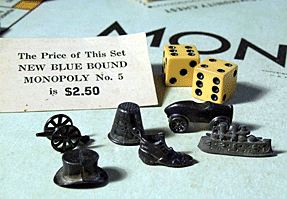 The Monopoly game tokens have come to reflect
the character of each player. Each token embodies a distinct
personality, from the regal top hat to the more practical thimble–and,
of course, the fast-moving race car. Other tokens included the
battleship, cannon, iron, race car, shoe, thimble, and top hat. In the
early 1950s, Parker Brothers added the dog, wheelbarrow and horse and
rider. The Monopoly game tokens have come to reflect
the character of each player. Each token embodies a distinct
personality, from the regal top hat to the more practical thimble–and,
of course, the fast-moving race car. Other tokens included the
battleship, cannon, iron, race car, shoe, thimble, and top hat. In the
early 1950s, Parker Brothers added the dog, wheelbarrow and horse and
rider.
High Profile Sets
The original White Box edition, mass
produced by Darrow and sold at Wanamaker’s Department Store in
Philadelphia in the early 1930’s, is the forerunner of the game first
produced by Parker Brothers. There are no numbers in the corners of the
money, only in the center. There are no tokens as the instructions say
to provide each player with their own token. And there are no values
showing on the squares on the board.
Forbes Magazine purchased three early monopoly
sets at auction. One had a square board, like the printed Parker
Brothers' games and a price tag of $23,000. It came with unpainted
houses and hotels cut from pine molding, old chips, scrip, and typed
Chance and Community Chest cards, deeds, and a set of rules typed on the
same typewriter as the rules that accompanied the set Forbes purchased
in December 1992. That set has a circular oilcloth board, probably an
earlier version made for use on Darrow's round dining table.
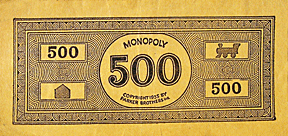 Another set, and a key one in the development
of Monopoly cost $17, 250. It’s laid out on a 22-inch square of pale
blue glazed fabric with properties marked by colored triangles at the
bottom, instead of bars at the top. It came with red-roofed,
gray-painted houses and hotels, Chance cards, deeds, and money. It
belonged to Charles E. Todd, who taught Darrow the game. Another set, and a key one in the development
of Monopoly cost $17, 250. It’s laid out on a 22-inch square of pale
blue glazed fabric with properties marked by colored triangles at the
bottom, instead of bars at the top. It came with red-roofed,
gray-painted houses and hotels, Chance cards, deeds, and money. It
belonged to Charles E. Todd, who taught Darrow the game.
A third set, a wooden hand-painted square game
board that cost $11,500 at auction, is probably earlier than the others.
It has 40 board divisions like the Atlantic City sets, but the place
names are for real estate in the counties surrounding Philadelphia:
Kimberton, Trappe, Ambler, Valley Forge, etc. More closely related to
the original Landlord’s Game, it has one corner marked "Mother
Earth" instead of "GO," and another corner square reads
"Government Grant, No Rents, No Taxes, Rest in Peace, and
Depart" instead of "Free Parking." Joseph A. Buckwalter
made this game in the 1920s.
Success
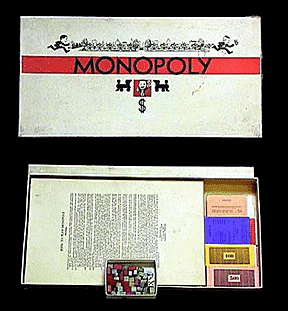 Today, Monopoly is the best-selling
board game in the world, licensed or sold in 80 countries and produced
in 26 languages including Croatian. It’s so much a part of today's
popular culture that Parker Brothers have trademarked many of its
graphic elements, including the tokens, Railroad, Community Chest,
Chance, and Title Deed designs, as well as Boardwalk and all four
gameboard corners. Today, Monopoly is the best-selling
board game in the world, licensed or sold in 80 countries and produced
in 26 languages including Croatian. It’s so much a part of today's
popular culture that Parker Brothers have trademarked many of its
graphic elements, including the tokens, Railroad, Community Chest,
Chance, and Title Deed designs, as well as Boardwalk and all four
gameboard corners.
Many editions of Monopoly exist beyond the
standard one. There are anniversary editions, luxury editions with solid
mahogany boards with drawers to store the playing pieces, European
editions, classic editions, standard editions, travel editions, junior
editions, etc. Classic editions are re-issues of earlier versions,
namely those that came in a black box with a separate board.
Standard editions are the most frequent
occurring sets, although the appearance continuously changes, depending
on the time of issue. In the early days, Parker Brothers issued many
nearly equal but slightly different versions, and since they bear no
reference numbers it’s very hard to distinguish and catalogue them.
Who Collects Monopoly
A small but enthusiastic group of
collectors collect Monopoly games. They collect the "official"
Parker Brothers’ games as well as the "related" games like
the States, Cities and University games, and Medical Monopoly (USA).
Collectors should use copyright dates printed
on the board to date their games. Even though Parker Brothers’
earliest date is 1935, they left "Charles Darrow 1933" on the
jail square in eight successive sets. Earlier games didn’t have
property prices printed on the board. Also, Chance, Community Chest, and
Luxury Tax cards have only text and no illustrations. The property cards
are also blank on older sets. Originally, the rent for Marvin Gardens
was $22 but was later changed to $24.
The Monopoly Market
While most monopoly games are worth a
modest sum, some of the rarer editions have sold for five figures. The
Forbes magazine collection has a monopoly on old Monopoly games. They
acquired three of them in 1994 for $11,500, $17, 250 and. $23,000,
adding to the one they bought in December 1992 for $71,500. But most
early standard games sell for around $100 in perfect condition.
The playing pieces sell for anywhere from $2 to
$20 each. One of the rarest tokens is the purse, found in only very
early editions. It sells now for $19. The original set sold by Parker
Brothers retailed for $2. Today, these same sets can go for $100 or
higher , with the game boards alone selling for at least $50 in good
condition.
Since 1935, its first year under Parker
Brothers’ ownership, Monopoly has been played by an estimated 500
million people. Today, many versions exist, with over 200 million games
having been sold worldwide. A set made by Alfred Dunhill, with gold
houses and silver hotels, sold for $25,000. The longest game in history
lasted 70 straight days. The longest game in a bathtub lasted 99 hours!
To read
more articles by Bob Brooke, please visit
his Web site. <
Back to Collectibles Archives
Next Article > |
